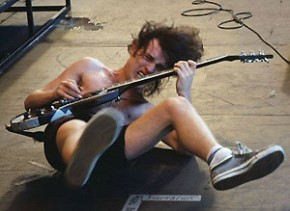 Hey Gear Vault readers! It’s been a while since I have written anything new for the site and I am very happy to be back here with you. My new project is a series of guitar lesson articles and videos aimed at helping you improve your basic guitar skills and get you well on your way to being the plank-spanking maniac you’ve always dreamed of becoming. These guitar lessons will cover the basic vocabulary of the guitar and some essential concepts that we all need to know. Learning this material will get you ready for the stage, which is where I like my students to be, and will help you build the confidence you need to get up there.
Hey Gear Vault readers! It’s been a while since I have written anything new for the site and I am very happy to be back here with you. My new project is a series of guitar lesson articles and videos aimed at helping you improve your basic guitar skills and get you well on your way to being the plank-spanking maniac you’ve always dreamed of becoming. These guitar lessons will cover the basic vocabulary of the guitar and some essential concepts that we all need to know. Learning this material will get you ready for the stage, which is where I like my students to be, and will help you build the confidence you need to get up there.
The first item on our must-know list is the humble power chord. A power chord is the chord we get by combing the first, or root, note, of a major or minor scale with the fifth note. Sometimes you will put the eighth note of the scale, the octave of the root, on top and sometimes not. When written in a chord chart, they are symbolized by the number 5, as in G5 or Bb5. They are pretty much the simplest type of chord ever, as they are neither Major nor Minor, and allow for a wide-open choice of notes to be used on top. We play them in Standard Tuning with the same first-and-third-finger grip across three different sets of strings, 6 & 5, 5 & 4, and 4 & 3 (E & A, A & D, D & G). In all three grips, the first finger is the root/name note of the chord, so the name of the note that your first finger is playing is also the name of the chord.
Power chords are the first key to the first door on the way to becoming a rock guitarist. They have been a basic element of rock almost since the beginning and can be found in literally thousands of songs ranging from ‘Can’t Explain’ by The Who to ‘Enter Sandman’ by Metallica and beyond. The grip is pretty easy; just make sure to keep your thumb just about dead center on the back of the neck. This gives you your longest and strongest left hand and makes the reach for your third finger a lot easier. The only real secrets to these are to keep your muscles locked when moving them around the neck to avoid having to re-set the chord at each location and to steer them visually by eyeballing the tip of your first finger. If your hand is locked in position, your third finger will tag along right into the proper spot. Just get that root note to the right fret and you’re money.
Power chords are typically played in 8th notes in both all downstrokes and down/up strums, depending on the rhythm at hand. To get started doing this, play all downs in groups of 8 and count 1 & 2 & 3 & 4 &, putting a downstroke on each count. The goal of this is not speed, at least not yet, but rhythmic steadiness. We want to lay down a wall-to-wall carpet of 8th note power chords in every measure. This is just playing the time, in the same way as the typical drummer would with his or her right hand. You can see me do this in the video that goes along with this article. You can also pick four chords of your own to do this with and write your own song. Just keep those fingers locked and your pick driving and it is hard to go wrong.
I am available for guitar lessons live and in person to anyone in the Chicago area and via Skype or MP3 anywhere else in the world for anyone who wants more info on power chords or any other aspect of guitar playing, songwriting, or producing. Please drop me a line atmikeocullmusic@aol.com to get started and also please visit www.mikeocull.com and www.facebook.com/StreetLevelGuitar. Keep watching this space for more cool guitar lessons and guitar tips! Peace.





Be the first to comment